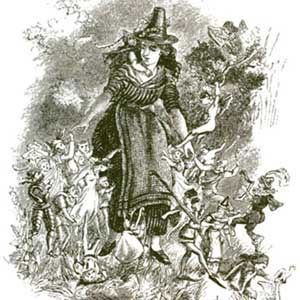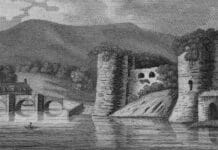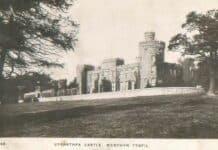Tylwyth Teg are Welsh fairies. NIA JONES takes a look at the compelling folklore surrounding the fair folk
Welsh faery-lore is believed to be closely related to the legend of King Arthur and Guinevere; some believe her abduction by Arthur was abduction by the faeries – of whom Arthur was King.
This links Arthur and Guinevere to the pagan beliefs of deities and spirits in nature.
Arthur’s half-sister Morgan le Fay was said to have lived in the underworld, possibly a faery burgh.
Every country’s faery legends have jovial sprites dancing in moonlight, the supernatural manipulation of time, confusing of the weather and the swapping of human children with changelings.
But in Welsh folklore faery interactions with humans feature much more heavily – where the kind and mindful are typically blessed with magic and the greedy and spiteful harshly punished.
Who are Y Tylwyth Teg?
Known anciently by the natives as “Y Tylwyth Teg” which literally means “the fair folk”, Welsh faeries typically live in lakes or streams and sometimes in hill hollows.
The magical entities are said to resemble stunning fair humans with glassy blue eyes and blonde-white hair. Smaller fairies are normally more virtuous and kindly- the taller fairies more mischievous and dishonest.
Usually they dress in green, but the courtiers of the Welsh Fairy King Gwyn ap Nudd are described as being adorned in blue/red silk.
There are various tales of humans being trapped in the fairy realm and the intermarriage between faeries and humankind.
Marriage in fairyland could be through consent or enslavement; either way you were forbidden to see your human family again, and may possibly forget your past human existence, but if contented, then the Welsh nation wished you well.
The most famous faery tale and associated artwork is that of a young Cardiganshire woman called Shuï Rhys, who allegedly went away with Y Tylwyth Teg and never returned.

The tale is recounted by Wirt Sikes in his 1880 book ‘British Goblins: Welsh Folk-lore, Fairy Mythology, Legends and Traditions’:
“Shuï was a beautiful girl of seventeen, tall and fair, with a skin like ivory, hair black and curling, and eyes of dark velvet.
She was but a poor farmer’s daughter, notwithstanding her beauty, and among her duties was that of driving up the cows for the milking.
Over this work she used to loiter sadly, to pick flowers by the way, or chase the butterflies, or amuse herself in any agreeable manner that fortune offered.
For her loitering she was often chided; indeed, people said Shuï’s mother was far too sharp with the girl, and that it was for no good the mother had so bitter a tongue.
After all the girl meant no harm, they said. But when one night Shuï never came home till bed-time, leaving the cows to care for themselves, dame Rhys took the girl to task as she never had done before.’ Ysgwaetheroedd, mami,’ said Shuï, ‘ I couldn’t help it, it was the Tylwyth Teg.’
The dame was aghast at this, but she could not answer it–for well she knew the Tylwyth Teg were often seen in the woods of Cardigan. Shuï was at first shy about talking of the fairies, but finally confessed they were little men in green coats, who danced around her and made music on their tiny harps; and they talked to her in language too beautiful to be repeated; indeed she couldn’t understand the words, though she knew well enough what the fairies meant.
Many a time after that Shuï was late; but now nobody chided her, for fear of offending the fairies.
At last one night Shuï did not come home at all. In alarm the woods were searched; there was no sign of her; and never was she seen in Cardigan again. Her mother watched in the fields on the Teir-nos Ysprydion or three nights of the year when goblins are sure to be abroad; but Shuï never returned.
Once indeed there came back to the neighbourhood a wild rumour that Shuï Rhys had been seen in a great city in a foreign land-Paris, perhaps, or London, who knows? but this tale was in no way injurious to the sad belief that the fairies had carried her off; they might take her to those well-known centres of idle and sinful pleasure, as well as to any other place.”
Many to this day believe that Wales is still a hive of faery activity, however, sightings of the supernatural are growing, but isolated faery sightings are depleting as they are more stigmatised and ridiculed.
How to meet Y Tylwyth Teg
Meeting Y Tylwyth Teg is not as tricky as you may imagine, because as we recall they have been known to welcome mortals into their ranks.
To increase your chances of bumping into Y Tylwyth Teg – visit a lake or an ancient place known for sightings at twilight or early dawn in Midsummer.
If you are very lucky you could attract one to your home as Y Tylwyth Teg have a penchant for visiting human dwellings after nightfall.
They particularly approve of a well kept orderly home with a tidy clean hearth, plus the thoughtful touch of a vessel containing some water, so they can quench their thirsts or freshen up before making their return journey to fairyland.










lovely to hear a wee welsh lore , i never knew, being scottish, findings are all the more of my interest, be it a wee selkie or nuckalavee,bring home the kelpies and keep us informed of more…i currently am reforming the black stick in swansea…a old tree spirit that is reticent about leaving its shielding of tree form and joining back into the worldly othermajik..thanks for keeping the spirits alive